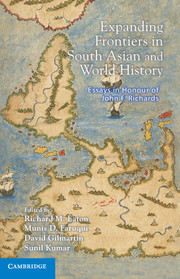Book contents
- Frontmatter
- Contents
- List of Contributors
- Foreword
- Introduction
- 1 At Empire's End: The Nizam, Hyderabad and Eighteenth-century India
- 2 The Ignored Elites: Turks, Mongols and a Persian Secretarial Class in the Early Delhi Sultanate
- 3 ‘Silk Road, Cotton Road or … Indo-Chinese Trade in Pre-European Times’
- 4 The Political Economy of Opium Smuggling in Early Nineteenth Century India: Leakage or Resistance?
- 5 Opium and the Company: Maritime Trade and Imperial Finances on Java, 1684–1796
- 6 The Mughals, the Sufi Shaikhs and the Formation of the Akbari Dispensation
- 7 Notes on Political Thought in Medieval and Early Modern South India
- 8 Becoming Turk the Rajput Way: Conversion and Identity in an Indian Warrior Narrative
- 9 Nature and Nurture on Imperial China's Frontiers
- 10 The Frontiers of Memory: What the Marathas Remembered of Vijayanagara
- 11 ‘Kiss My Foot,’ Said the King: Firearms, Diplomacy and the Battle for Raichur, 1520
- 12 Frontiers of Family Life: Early Modern Atlantic and Indian Ocean Worlds
- 13 Chinese Revenue Farms and Borders in Southeast Asia
- Publications
- Index
13 - Chinese Revenue Farms and Borders in Southeast Asia
Published online by Cambridge University Press: 05 January 2014
- Frontmatter
- Contents
- List of Contributors
- Foreword
- Introduction
- 1 At Empire's End: The Nizam, Hyderabad and Eighteenth-century India
- 2 The Ignored Elites: Turks, Mongols and a Persian Secretarial Class in the Early Delhi Sultanate
- 3 ‘Silk Road, Cotton Road or … Indo-Chinese Trade in Pre-European Times’
- 4 The Political Economy of Opium Smuggling in Early Nineteenth Century India: Leakage or Resistance?
- 5 Opium and the Company: Maritime Trade and Imperial Finances on Java, 1684–1796
- 6 The Mughals, the Sufi Shaikhs and the Formation of the Akbari Dispensation
- 7 Notes on Political Thought in Medieval and Early Modern South India
- 8 Becoming Turk the Rajput Way: Conversion and Identity in an Indian Warrior Narrative
- 9 Nature and Nurture on Imperial China's Frontiers
- 10 The Frontiers of Memory: What the Marathas Remembered of Vijayanagara
- 11 ‘Kiss My Foot,’ Said the King: Firearms, Diplomacy and the Battle for Raichur, 1520
- 12 Frontiers of Family Life: Early Modern Atlantic and Indian Ocean Worlds
- 13 Chinese Revenue Farms and Borders in Southeast Asia
- Publications
- Index
Summary
INTRODUCTION
This essay examines the role of Chinese revenue farmers in defining the borders of the various colonial territories and the states of Southeast Asia during the nineteenth century. The role of these individuals has largely been neglected in the current writing on the formation of state boundaries. Nicholas Tarling, in his Southeast Asia: A Modern History, notes, ‘Between the late eighteenth and the early twentieth almost all southeast Asia was divided into colonies or protectorates held by the Western powers, and new boundaries were drawn with the object of avoiding conflict among them’. His view is typical of most who have studied the period.
While his comment acknowledges the role of the Western powers in surveying the boundaries, drafting treaties and map making, it really says nothing about how those divisions were actually policed and made real on the ground. This aspect of ‘border making’ was left to the independent Chinese monopolists who worked on behalf of the colonial regimes. This essay examines their role during the middle years of the nineteenth century and attempts to give an account of their significance in the organization of colonial governance and in giving substance to the formalistic pronouncements of remote diplomats and statesmen.
BORDERS AND POPULATIONS
Southeast Asia presents a unique case historically because despite the fact that the major states have long-standing historical traditions, until the nineteenth century, most lacked clearly defined borders.
- Type
- Chapter
- Information
- Expanding Frontiers in South Asian and World HistoryEssays in Honour of John F. Richards, pp. 318 - 346Publisher: Cambridge University PressPrint publication year: 2013



